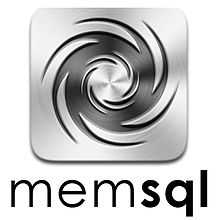MemSQL
 | |
| Developer(s) | MemSQL, Inc. |
|---|---|
| Stable release | 2.0 / April 23, 2013 |
| Written in | C++ |
| Operating system | Linux |
| Type | RDBMS |
| License | Proprietary License |
| Website | memsql.com |
MemSQL is a distributed, in-memory database that is part of the NewSQL movement.[1] It is an ACID-compliant RDBMS that most notably converts SQL into C++ through code generation. MemSQL was founded in 2011 and is a graduate of the Y Combinator startup program. MemSQL has raised more than $5 million to date from a variety of investors including First Round Capital, IA Ventures, NEA, and several prominent angels including Paul Buchheit, Max Levchin, Aaron Levie, and Ashton Kutcher.[2] MemSQL launched its database to the public on June 18, 2012.[3]
Core Technology
MemSQL combines lock-free data structures and a just-in-time (JIT) compiler for processing highly volatile workloads.[4] More specifically, MemSQL implements lock-free hash tables and lock-free skiplists in memory for fast random access to data. Queries sent to the MemSQL server are converted into C++ and compiled through GCC.[5] Queries are stripped of their parameters and the query template is stored as a shared object which is subsequently matched against incoming queries to the system. Code generation and the execution of pre-compiled query plans removes interpretation along hot code paths, providing highly efficient code paths that minimize the number of CPU instructions required.
MemSQL is wire-compatible with MySQL.[6] Applications can connect to MemSQL through standard ODBC/JDBC connectors as well as MySQL clients and drivers.[7]
Durability
Even though MemSQL stores data in memory, MemSQL is durable by implementing a write-ahead log and snapshots (similar to checkpoints). On default settings, as soon as a transaction is acknowledged in memory, the database will write the transaction to disk as fast as the disk will allow.[8]
Replication
MemSQL supports a native replication protocol that ships its transactional log to slaves. MemSQL currently supports master-slave replication.
Distributed Architecture
MemSQL is a distributed database that works by the concept of aggegators and leaf nodes.[9] An aggregator is responsible for breaking up the query across the relevant leaf nodes and aggregating results back to the client. A leaf node is a MemSQL database. MemSQL uses hash partitioning to distribute data uniformly across the number of leaf nodes.[10] MemSQL made the distributed version of its system generally available on April 23, 2013[11] with a trial edition available for download on their website.[12]
Version History
MemSQL 1b - first general availability in June, 2012.[13]
MemSQL 1c - minor feature update, released July 2012.
MemSQL 1.8 - replication and expanded SQL surface area, released December 2012
MemSQL 2.0 - general availability of distributed system.[14] First release of MemSQL Watch operational dashboard.[15]
References
- ↑ "MemSQL". Retrieved 2012-10-07.
- ↑ Empson, Rip (2012). "Accelerate Your Database: MemSQL Launches With $5M From Ashton Kutcher, Max Levchin & More" (published 2012-06-18). Retrieved 2012-10-07.
- ↑ Harris, Derrick (2012). "Ex-Facebookers Launch MemSQL to Make your Database Fly" (published 2012-06-18). Retrieved 2012-10-07.
- ↑ http://vimeo.com/44087431
- ↑ http://developers.memsql.com/docs/1c/codegen.html
- ↑ http://developers.memsql.com/docs/1c/cli.html
- ↑ http://www.i-programmer.info/news/84-database/4397-memsql-80000-queries-per-second.html
- ↑ http://developers.memsql.com/docs/1c/faq.html#durability
- ↑ http://highscalability.com/blog/2012/8/14/memsql-architecture-the-fast-mvcc-inmem-lockfree-codegen-and.html
- ↑ http://www.dbms2.com/2012/06/18/introduction-to-memsql/
- ↑ http://www.dbms2.com/2013/04/23/memsql-scales-out/
- ↑ http://www.memsql.com/download
- ↑ http://vimeo.com/44087431
- ↑ http://www.dbms2.com/2013/04/23/memsql-scales-out/
- ↑ http://developers.memsql.com/docs/2.0/2.0releasenotes.html
External links
- Official website
- http://www.businessweek.com/articles/2012-06-28/enterprise-technology-revenge-of-the-nerdiest-nerds